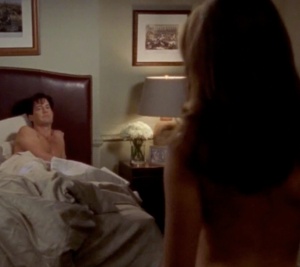Materialism to Impress Men
Main character, Carrie Bradshaw, is defined by her sense of fashion and her unique ability to create quirky yet inspiring outfits. Her fashion choices “act as signifiers to [her] multi-faceted personality,” and both define who she is to us as viewers, as well as who she is to other characters inside the diegesis of the show (Kuruc, 208). Carrie herself believes that her identity is shaped by her clothing, and uses fashion as a way to impress men that she encounters.
Although in many ways the show attempts to code Carrie as a reformed and independent woman, her particularly great sense of concern for her appearance, especially in the presence of men, frames her as fashion obsessed and materialistic. When around her female friends Carrie is often seen without her hair done and with very light make up on. Yet, when she knows that men will be around, Carrie would not dare be seen dressed in anything less than her best.
In the Season Six premiere episode, “To Market, To Market,” Carrie is seen drinking coffee with Miranda, wearing a small pink sweater over a voluminous peasant shirt and baggy jeans. She is not wearing make-up, and her hair is messy, simply pulled back behind a headband. This outfit is a stark juxtaposition to her normal attire, and in an “ironic” bout of fate, Carrie sees the man who she is going on a date with later that night. She immediately gets all worked up, claiming “I look like shit!” and “This is not my perfect outfit!” (“To Market, To Market”). Around Miranda, Carrie had no qualms about her outfit, yet around a man, she is worried that her lack of style may make her attractive and therefore less desirable and worthwhile. The camera then follows Carrie as she runs through the busy streets of New York, doing all that she can to avoid being seen in this “less than perfect” ensemble in front of a man that she wants to impress. This long cut helps us as viewers to become invested in the scene; we feel as if we are running with Carrie, doing all that we can to avoid the embarrassment of being seen in such garb.
This constant need to impress and attract men through fashion and clothing challenges the notion that Carrie has successfully redefined what it means to be a modern woman. Rather than obtaining power, she simply perpetuates feminine hegemonic roles. Her obsession with appearance makes her seem both shallow and materialistic, and thereby feeds into the traditional belief that women are expected to dress nicely for their male counterparts. And more importantly, this works to demotes Carrie, and all women, to the position of the disempowered, subservient gender.




